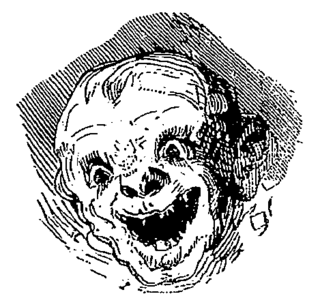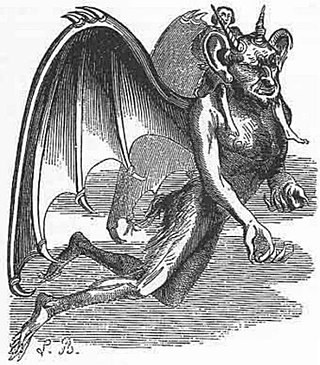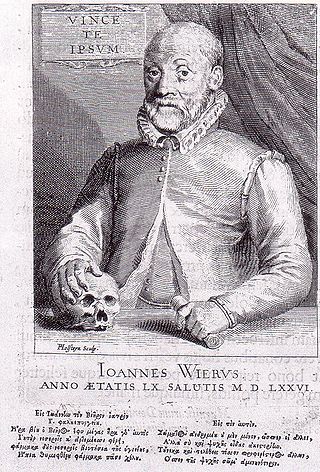Related Research Articles

Aamon, in demonology, is a Grand Marquis of Hell who governs 40 infernal legions, and the 7th spirit of the Goetia. He is the demon of life and reproduction.

Bael is a demon described in demonological grimoires such as The Lesser Key of Solomon and the Pseudomonarchia Daemonum and also in the Dictionnaire Infernal. He is described as a hoarsely-voiced king with the power to make men invisible and ruling over sixty-six legions of demons. The Lesser Key of Solomon describes him as appearing in the form of a cat, toad, man, some combination thereof, or other "diverse shapes", while the Pseudomonarchia Daemonum and the Dictionnaire Infernal state that he appears with the heads of a cat, toad, and human simultaneously.

Alloces is a demon that appears in demonological grimoires such as the Liber Officiorum Spirituum, Pseudomonarchia Daemonum, and the Lesser Key of Solomon. He is described in the Lesser Key of Solomon and in the Pseudomonarchia Daemonum as a duke, taking the form of a fire-breathing, lion-headed soldier riding a horse. His purported duties include teaching astronomy and liberal sciences, and granting familiars. He is claimed to have 36 legions of demons under his command. In the Liber Officiorum Spirituum, Alloces appears as Allogor or Algor, again a duke, but otherwise with a completely different appearance and abilities -- a spear-toting knight who answers questions, provides advice for plans, and commands only 30 legions of demons. In duplicate entry, Alloces appears as Algor, ruled by the spirit "Orience" (Oriens), again as a knight who explains secrets, but with the additional power of garnering the favor of nobles. According to Rudd, Allocer is opposed by the Shemhamphorasch angel Imamiah.
Vine is a demon listed in demonological grimoires such the Lesser Key of Solomon Johann Weyer's Pseudomonarchia Daemonum, and Jacques Collin de Plancy's Dictionnaire Infernal.

Bifrons is a demon described in the demonological grimoires the Lesser Key of Solomon and the Pseudomonarchia Daemonum, as well as being mentioned in the Dictionnaire Infernal. These works describe Bifrons as an earl who initially appears as a monster before adopting a more human form. His duties include teaching arts and sciences, including astrology, geometry, and the properties of different plants and stones. He also moves bodies into different graves, lights candles over graves, and commands either 6, 26, or 60 legions of spirits.
The Lesser Key of Solomon, also known as Lemegeton Clavicula Salomonis or simply Lemegeton, is an anonymously authored grimoire on sorcery. It was compiled in the mid-17th century, mostly from materials several centuries older. It is divided into five books: the Ars Goetia, Ars Theurgia-Goetia, Ars Paulina, Ars Almadel, and Ars Notoria. It is based on the Testament of Solomon and the ring mentioned within it that he used to seal demons.

Agares is a demon described in demonological grimoires.
In demonology, Halphas is the thirty-eighth demon in the Ars Goetia in the Lesser Key of Solomon, ranked as an earl.
Pseudomonarchia Daemonum, or False Monarchy of Demons, first appears as an Appendix to De praestigiis daemonum (1577) by Johann Weyer. An abridgment of a grimoire similar in nature to the Ars Goetia, it contains a list of demons, and the appropriate hours and rituals to conjure them.
Vassago is a demon described in demonological grimoires such as the Lesser Key of Solomon and the Book of the Office of Spirits.
Bathin is a demon described in demonological grimoires.
Gamigin is a demon described in demonological grimoires such as The Lesser Key of Solomon and Johann Weyer's Pseudomonarchia Daemonum.

Paimon is a spirit named in early grimoires. These include The Lesser Key of Solomon, Johann Weyer's Pseudomonarchia Daemonum, Collin de Plancy's Dictionnaire Infernal, the Livre des Esperitz, the Liber Officiorum Spirituum, The Book of Abramelin, and certain French editions of The Grimoire of Pope Honorius ; as well as British Library, Sloane MS 3824.
Leraje is a demon mentioned in demonological grimoires. He appears in the Lesser Key of Solomon, Johann Weyer's Pseudomonarchia Daemonum, and Jacques Collin de Plancy's Dictionnaire Infernal.
Botis, sometimes Otis, is a demon described in the Lesser Key of Solomon and the Pseudomonarchia Daemonum as a President and an Earl who initially appears as a viper before changing into a sword-toting, fanged, and horned human who discusses matters past, present, and future; brings favor from allies and enemies, and rules 60 legions of demons. In the Munich Manual of Demonic Magic, Botis appears as Otius, and is mostly identical except that he is a preses and Count, appears in the more humanoid form to begin with, and rules only 36 legions of demons. In the Grand Grimoire, Botis appears as a subordinate of Agaliarept. According to Rudd, Botis is opposed by the Shemhamphorasch angel Lauviah.

Gaap is a demon that is described in demonological grimoires such as the Lesser Key of Solomon, Johann Weyer's Pseudomonarchia Daemonum, and the Munich Manual of Demonic Magic, as well as Jacques Collin de Plancy's Dictionnaire Infernal,

Gemory is a demon listed in demonological grimoires.

Valac is a demon described in the goetic grimoires The Lesser Key of Solomon, Johann Weyer's Pseudomonarchia Daemonum, the Liber Officiorum Spirituum, and in the Munich Manual of Demonic Magic as an angelically winged boy riding a two-headed dragon, attributed with the power of finding treasures.
Amy is a demon described in demonological grimoires such as the Lesser Key of Solomon, the Pseudomonarchia Daemonum, and in the Munich Manual of Demonic Magic; as well as Jacques Collin de Plancy Dictionnaire Infernal,

De praestigiis daemonum, translated as On the Tricks of Demons, is a book by medical doctor Johann Weyer, also known as Wier, first published in Basel in 1563. The book argues that witchcraft does not exist and that those who claim to practice it are suffering from delusions, which should be treated as mental illnesses, rather than punished as witchcraft. It was influential in the abolishment of witchcraft trials in the Netherlands.
References
- 1 2 A Book of the Office of Spirits; John Porter, Trans. Frederick Hockley, Ed. Colin D. Campbell; Teitan Press, 2011.
- 1 2 The Book of Oberon, eds. Daniel Harms and Joseph Peterson, Llewllyn Publications, 2015
- 1 2 3 4 5 6 7 8 Porter, Hockley, Campbell, p.vii-xvii
- 1 2 3 4 The Book of Oberon, eds. Daniel Harms and Joseph Peterson, Llewllyn Publications, 2015, p.1-30
- ↑ Trithemius' catalogue of necromantic books, hosted at Twilit Grotto -- Esoteric Archives.
- ↑ Lemegeton Clavicula Salomonis: The Lesser Key of Solomon, Detailing the Ceremonial Art of Commanding Spirits Both Good and Evil; ed. Joseph H. Peterson; Weiser Books, Maine; 2001. p. xiii
- ↑ Pseudomonarchia Daemonum (Liber officiorum spirituum); Johann Weyer, ed. Joseph Peterson; 2000. Available online at Esoteric Archives
- ↑ The Goetia of Dr Rudd; Thomas Rudd, Ed. Stephen Skinner & David Rankine; 2007, Golden Hoard Press. pp. 20, 34-37, 101
- 1 2 Porter, Hockley, Campbell, p. 59, 73
- ↑ Rudd, Skinner & Rankine, p. 95
- 1 2 3 4 5 6 7 8 9 10 11 12 13 14 15 16 17 18 19 20 Harms, Peterson, p.191-207
- 1 2 3 4 5 6 7 8 9 10 11 12 13 14 15 16 17 18 19 20 21 Harms, Peterson, p.208-215
- ↑ Harms, Peterson, p.215-234
- ↑ Harms, Peterson, p.234-235
- ↑ Harms, Peterson, p.236-290, especially footnotes
- ↑ Harms, Peterson, p.290-319
- ↑ Harms, Peterson, p.319-339
- ↑ Harms, Peterson, p.340-345
- ↑ Harms, Peterson, p.346-364
- ↑ Harms, Peterson, p.364-369
- ↑ Harms, Peterson, p.370-381
- ↑ Harms, Peterson, p.382-387
- ↑ Harms, Peterson, p.388-453
- ↑ Harms, Peterson, p.454-490
- 1 2 3 4 5 6 7 8 Porter, Hockley, Campbell, p.1-9
- 1 2 3 4 5 6 7 8 9 Porter, Hockley, Campbell, p.10-19
- 1 2 3 4 5 6 7 8 9 10 11 12 13 Porter, Hockley, Campbell, p.20-29
- 1 2 3 4 5 6 7 8 9 10 11 12 13 14 15 Porter, Hockley, Campbell, p.30-39
- 1 2 3 4 Porter, Hockley, Campbell, p.70-77
- ↑ Porter, Hockley, Campbell, p.59-69
- ↑ Elias Ashmole, ed. David Rankine, The Book of Treasure Spirits, Avalonia books, 2009; p. 2 and 109 (fn.88)